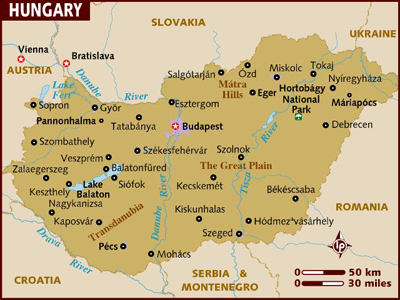Tale of Two (Three?) Cities

Two weeks ago, I took a day trip with a friend to Budapest, the capital and largest city of Hungary. The city originally consisted of three towns--Buda, Pest, and Óbuda—which were combined in 1873 to form the capital. Today, the Danube River divides Budapest, with Buda in the west and Pest in the east. Óbuda, translated as “Old Buda”, forms District III of the Buda side of Budapest.
Budapest is about three hours by train southeast of Vienna. When we arrived in the city, the first thing I noticed was how similar it is to Vienna, just a tad more Eastern European. Of course, that’s because Austria and Hungary used to be part of the Austro-Hungarian Empire, so the architecture and design of the two cities are quite similar.
Every so often, we saw signs of German-language influence. We recognized a few words on street signs or menus and overheard some German conversations (though probably from tourists). The Hungarian language actually belongs to the Uralic family of languages, to which Finnish and Estonian also belong. Therefore, the biggest German influence is just words that have been imported from one language to another; Hungarian has no true German roots. Hungarian sounds similar to many of the Slavic languages and is considered one of the most difficult for English-speakers to learn.
Armed with a travel guide and phrase book, we gave ourselves an interesting tour of the city. Not thinking that we were traveling on an Austrian (aka Catholic) holiday, we were a bit surprised to find everything in Budapest closed. Apparently, it was not only a state holiday in Austria—“Christi Himmelfahrt” or “The Ascension”—but it was also a state holiday in Hungary. Ooops! We made the best of our day and visited all of the outside landmarks, which took the entire day anyway!
We spent most of our time walking along the Danube River. It’s a long river! It was somehow comforting to know we could follow the same river we see every day in Vienna into another country with a completely different culture. The people change, but the river remains the same.
Throughout the day, we visited the most important outdoor sites: the Parliament, St. Stephen Basilica (the largest Catholic church in Budapest), the state opera, the Buda Castle (residence of Hungarian kings since the 13th century), the Castle District (how cool! I want to live in a city with a castle district!), the Citadel fortress, the National Library, and the Palace of the Arts. I’m sure we passed plenty of other landmarks that we just didn’t recognize.
One of the most moving sights was not marked in any guidebook, but was rather an outdoor memorial installation.

A line of old shoes marked the area where Arrow Cross militiamen, the Hungarian Nazis, shot countless lines of Hungarian Jews into the Danube River. The shoes represent these victims. It’s sobering to realize that wherever you travel in Europe, you are always reminded of the Nazi past.
After a full day of sightseeing, we boarded the train around 8pm in Budapest to arrive in Vienna around 11. School and work dragged by on Friday, both from exhaustion and the lingering “travel mode”. I slept soundly Friday night to wake up to a bright, sunny day on Saturday – perfect for spending outside in Vienna!

0 Comments:
Post a Comment
Subscribe to Post Comments [Atom]
<< Home